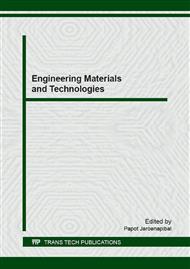p.45
p.51
p.57
p.62
p.67
p.72
p.77
p.81
p.87
Synthesis, Characterization and Performance Validation of Hybrid Cation Exchanger Containing Hydrated Ferric Oxide Nanoparticles (HCIX-Fe) for Lead Removal from Battery Manufacturing Wastewater
Abstract:
This study is aimed to synthesize, characterize and validate the performance of a novel hybrid nanoadsorbent for selective removal of lead from a battery manufacturing wastewater. The hybrid nanosorbent, named as HCIX-Fe, was prepared by impregnating hydrated Fe (III) oxide (HFO) nanoparticles inside polymeric cation exchange resin containing negatively charged sulfonic acid (-SO3-) fixed functional groups. HCIX-Fe was characterized by SEM-EDX and XRD to confirm the distribution and determination of phase of HFO dispersed inside the hybrid nanosorbent. Fixed-bed column runs with HCIX-Fe beads were carried out using wastewater from a battery manufacturing plant. The wastewater had a pH of 1.8 and contained of 3.5 mg/L of Pb2+ coexisted with 250 mg/L Ca2+ ions. The results have shown that HCIX-Fe column could treat lead-contaminated water up to 6,500 bed volumes (BVs) before the occurrence of breakthrough concentration of 0.2 mg/L Pb2+ resulting in a removal capacity of 6.85 mg Pb2+/ml of the HCIX-Fe bed. Under similar condition, adsorbent columns with cation exchange resin (C100), granulated activated carbon (GAC) and granulated activated carbon impregnated with HFO (GAC-Fe), could treat the same wastewater only until 400, 900 and 1,500 BVs, respectively. When compared with the parent adsorbents, impregnation by HFO greatly enhanced the Pb2+ removal capacity of C100 and GAC by 1,625% and 167%, respectively. Both HFO and high density of sulfonic acid (-SO3-) in the host cation exchanger are individually capable of selective removal of Pb2+ ions; however the hybrid material demonstrated a synergistic effect for Pb2+ removal through the Donnan Membrane effect. Due to amphoteric behavior of HFO, the HCIX-Fe could be regenerated and reused with 10 BVs of 2% HNO3 and 1% FeCl3·6H2O solution.
Info:
Periodical:
Pages:
67-71
Citation:
Online since:
November 2016
Keywords:
Price:
Сopyright:
© 2017 Trans Tech Publications Ltd. All Rights Reserved
Share:
Citation:


